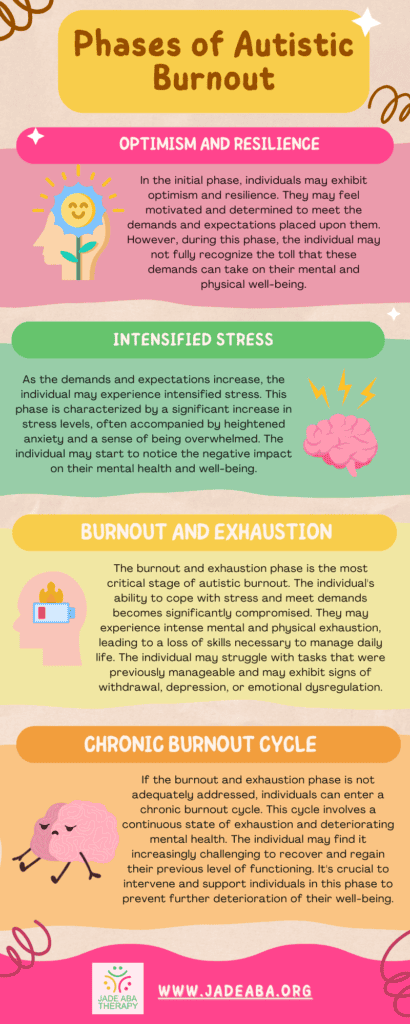Autistic burnout is a long-term condition experienced by individuals on the autism spectrum, characterized by an exhaustion of internal resources. It is important to understand the definition, characteristics, as well as the triggers and risk factors associated with autistic burnout.

Definition and Characteristics of Autistic Burnout
Autistic burnout is a state of chronic physical and mental fatigue that affects individuals with autism. It is often characterized by pervasive exhaustion, increased sensitivities, and a loss of executive functioning skills. This can result in difficulties with communication, social interaction, and daily functioning.
Autistic burnout can manifest differently in each individual, but common symptoms include:
- Pervasive fatigue and overwhelming tiredness
- Increased sensitivities to sensory stimuli
- Difficulty with processing information and cognitive functioning
- Impairments in executive functioning, such as planning, organizing, and decision-making
- Challenges in social interactions and maintaining relationships
- Heightened emotional reactivity and difficulties with emotional regulation
It is important to note that autistic burnout can often lead to periods of depression, as the chronic exhaustion and challenges associated with burnout can take a toll on an individual’s mental well-being. By identifying and addressing autistic burnout early on, the likelihood of sliding into depression can be significantly reduced.
Triggers and Risk Factors
Autistic burnout is often triggered by the attempt to function in a non-autistic world without the necessary support. The pressure to conform to societal expectations and the energy required for masking (camouflaging autistic traits) can be overwhelming and lead to burnout. This is particularly true for individuals on the autism spectrum who engage in high levels of masking, also known as high-masking autistics.
Some common triggers and risk factors for autistic burnout include:
- Excessive demands and expectations from work, school, or daily responsibilities
- Sensory overload and overstimulation in environments with bright lights, loud noises, or strong smells
- Lack of understanding and support from family, friends, or co-workers
- Social isolation and difficulties in forming and maintaining relationships
- Emotional and psychological stressors related to living in a society that may not fully accommodate autistic needs
By recognizing these triggers and risk factors, individuals with autism and their support networks can take proactive steps to prevent or mitigate autistic burnout. Building a supportive environment, reducing demands and obligations, and engaging in stress management techniques are essential in managing and preventing burnout.
Symptoms of Autistic Burnout
Autistic burnout is a long-term condition characterized by exhaustion of internal resources in individuals with autism. It is important to recognize the symptoms of autistic burnout in order to provide appropriate support and intervention. The symptoms of autistic burnout can vary from person to person, but commonly include:
Physical and Emotional Exhaustion
One of the hallmark symptoms of autistic burnout is pervasive physical and emotional exhaustion. This exhaustion is often more intense and long-lasting than typical tiredness. It may feel like a deep fatigue that affects daily functioning and reduces overall energy levels. Autistic individuals experiencing burnout may find it challenging to engage in activities they once enjoyed due to overwhelming exhaustion.
Cognitive Challenges
Autistic burnout can lead to cognitive difficulties that impact various aspects of daily life. Individuals may experience cognitive overload, making it difficult to process information and make decisions. Tasks that were once manageable may become overwhelming, leading to difficulties in planning, organizing, and problem-solving. Changes in routine can be particularly distressing, and individuals may exhibit avoidance behaviors or become stuck when transitioning between activities.
Executive Functioning Impairments
Executive functioning refers to a set of cognitive skills that help individuals manage and regulate their behavior. Autistic burnout can significantly impact executive functioning, making tasks that require organization, time management, and decision-making more challenging. Individuals may struggle with planning and initiating tasks, maintaining focus, and effectively managing their time. Decision-making may become arduous, leading to procrastination or dependence on others for choices.

Social Difficulties
Autistic burnout can have a significant impact on social interactions. Individuals may experience heightened stress in social situations and find it challenging to respond appropriately in conversations. Maintaining eye contact may be stressful, and individuals may feel drained by the effort required to mask their social expressions. These difficulties can lead to increased social withdrawal and feelings of isolation.
Sensory Sensitivities
Sensory sensitivities are a common symptom of autistic burnout. Autistic individuals may experience heightened sensitivity to certain stimuli and may develop new sensitivities during burnout. This can manifest as discomfort with noises, smells, textures, or bright lights. The need for stimming behaviors, such as rocking or hand-flapping, may also increase during burnout as a way to regulate sensory input. Additionally, individuals may gravitate towards specific foods or eating patterns for comfort during this period.
Recognizing and understanding these symptoms is crucial for providing support and accommodations to individuals experiencing autistic burnout. By acknowledging and addressing these challenges, individuals can work towards managing burnout symptoms and promoting overall well-being.
Phases of Autistic Burnout
Autistic burnout is a complex and challenging experience that can progress through several distinct phases. Understanding these phases is crucial for recognizing and managing autistic burnout symptoms. Let’s explore the different phases individuals may go through during autistic burnout:

Recognizing these phases of autistic burnout is essential for individuals, caregivers, and professionals. By identifying the signs and symptoms at each stage, appropriate interventions and support can be provided to manage and alleviate the impact of burnout. Understanding that autistic burnout is not a personal failure but a consequence of attempting to meet overwhelming demands is crucial in fostering empathy and support for individuals experiencing this challenge.
Impact on Daily Life
Autistic burnout can have a significant impact on various aspects of daily life, including work and responsibilities, family and relationships, and self-care and independence. Understanding these impacts is crucial in providing support and developing effective coping strategies.
Work and Responsibilities
Autistic burnout can make it challenging to manage work responsibilities effectively. Chronic exhaustion and fatigue can lead to decreased productivity and difficulties in meeting deadlines. The loss of interest and engagement in special interests, which are often a source of motivation and focus, can further contribute to the struggles at work.
Individuals experiencing burnout may find it difficult to cope with the demands of the workplace, leading to increased stress and potential conflicts. It is important for employers and colleagues to be aware of the impact of burnout on autistic individuals and provide necessary accommodations and support.
Family and Relationships
Autistic burnout can also impact family dynamics and relationships. The intense mental and physical exhaustion associated with burnout can make it challenging to maintain the level of engagement and interaction that family members may expect. This can lead to misunderstandings, frustration, and strain on relationships.
Communication difficulties, changes in routine, and difficulties with decision-making and planning, which are common during burnout, can further contribute to challenges within family dynamics. It is important for family members to have a supportive and understanding approach, allowing the individual with autism to communicate their needs and providing necessary accommodations.
Self-Care and Independence
One of the significant impacts of autistic burnout is the decline in self-care and independence. The chronic exhaustion and loss of skills necessary to manage daily life can result in a reduced ability to tend to personal needs. This can lead to a loss of independence and reliance on others for support in daily activities.
Individuals experiencing burnout may find it difficult to engage in self-care practices that were once enjoyable or necessary for their well-being. It is crucial to prioritize rest and self-care during this time, as it can help in the recovery process. Seeking professional help, building social connections and support, and implementing stress management techniques are essential in managing burnout.

Managing Autistic Burnout
When it comes to managing autistic burnout symptoms, it’s important to prioritize self-care and seek support from professionals and social connections. By implementing effective strategies, individuals with autism can better cope with burnout and improve their overall well-being. Here are some key approaches to consider:
Rest and Self-Care Practices
Rest and self-care practices play a vital role in managing autistic burnout. Taking regular breaks, setting boundaries, and establishing a consistent sleep routine can help reduce exhaustion and replenish energy levels. Engaging in activities that bring joy and relaxation, such as hobbies, mindfulness exercises, or sensory-focused activities, can also provide a much-needed respite.
Seeking Professional Help
Seeking professional help is essential in managing autistic burnout. Mental health professionals, such as therapists or counselors experienced in working with individuals on the autism spectrum, can provide valuable guidance and support. They can help individuals develop coping strategies, navigate emotional challenges, and address any underlying mental health concerns. Additionally, professionals can assist in identifying and addressing early signs of burnout.
Social Connections and Support
Maintaining social connections and seeking support from others are crucial aspects of managing autistic burnout. Connecting with understanding friends, family members, or support groups can provide a sense of belonging and validation. Sharing experiences and challenges with individuals who can relate can be comforting and provide valuable insights. Online communities and forums dedicated to autism can also be a valuable resource for finding support and advice.
Stress Management Techniques
Implementing stress management techniques can be instrumental in managing autistic burnout. Techniques such as deep breathing exercises, meditation, yoga, or engaging in physical activities can help reduce stress levels and promote relaxation. It’s important to find techniques that resonate with the individual’s preferences and sensory needs.
By implementing these strategies, individuals with autism can effectively manage burnout and improve their overall well-being. It’s essential to tailor these approaches to individual needs and preferences, as what works for one person may not work for another.
Remember, managing autistic burnout is an ongoing process that may require some trial and error to identify the most effective strategies. With time, patience, and support, individuals with autism can thrive beyond burnout and lead fulfilling lives.

Autistic Burnout: Prevention Strategies
By taking proactive steps, individuals with autism can minimize the risk of burnout and maintain their well-being. Here are some effective prevention strategies to consider:
Reducing Demands and Obligations
One of the key strategies in preventing autistic burnout is to reduce demands and obligations. This involves creating a balanced schedule that allows for rest and recovery. It’s important to prioritize activities and responsibilities, focusing on those that are essential and manageable. By setting realistic expectations and boundaries, individuals can prevent overwhelming and exhausting situations.
Engaging in Stimming Activities
Engaging in stimming activities can be beneficial in preventing autistic burnout. Stimming refers to self-stimulatory behaviors that help individuals regulate their sensory experiences. These activities, such as rocking, hand-flapping, or repetitive movements, can provide comfort and reduce stress. Encouraging and embracing stimming activities can help individuals with autism maintain a sense of calm and prevent burnout.
Identifying and Addressing Early Signs
Recognizing and addressing early signs of burnout is crucial in preventing its escalation. It’s important to pay attention to changes in mood, behavior, or energy levels. If individuals notice increased fatigue, irritability, or difficulty in managing daily activities, it may be an indication that burnout is approaching. By promptly addressing these signs, individuals can take the necessary steps to prevent burnout from worsening.
Building a Supportive Environment
Creating a supportive environment is vital in preventing autistic burnout. This involves establishing open communication and understanding within personal and professional relationships. Supportive friends, family members, and colleagues can provide valuable assistance and help alleviate stress. Additionally, seeking out support groups or online communities of individuals with autism can provide a sense of belonging and understanding.
By implementing these prevention strategies, individuals with autism can proactively manage their well-being and reduce the risk of burnout. It’s important to remember that everyone’s experience with burnout is unique, and finding the most effective strategies may require some trial and error. Seeking professional guidance and support from autism and mental health professionals can also be beneficial in developing personalized prevention plans.
Sources:
- https://neurodivergentinsights.com/blog/autistic-burnout-symptoms
- https://www.wtcsb.org/autistic-burnout-as-an-autistic-adult-with-responsibilities/
- https://www.autismspeaks.org/tool-kit-excerpt/autistic-burnout-when-navigating-neurotypical-world-becomes-too-much#:~:text=Autistic%20burnout%20might%20look%20like%3A&text=Withdrawing%20from%20your%20usual%20social,cooking%2C%20cleaning%20or%20personal%20hygiene
- https://www.dralicenicholls.com/am-i-in-autistic-burnout-signs-and-symptoms/